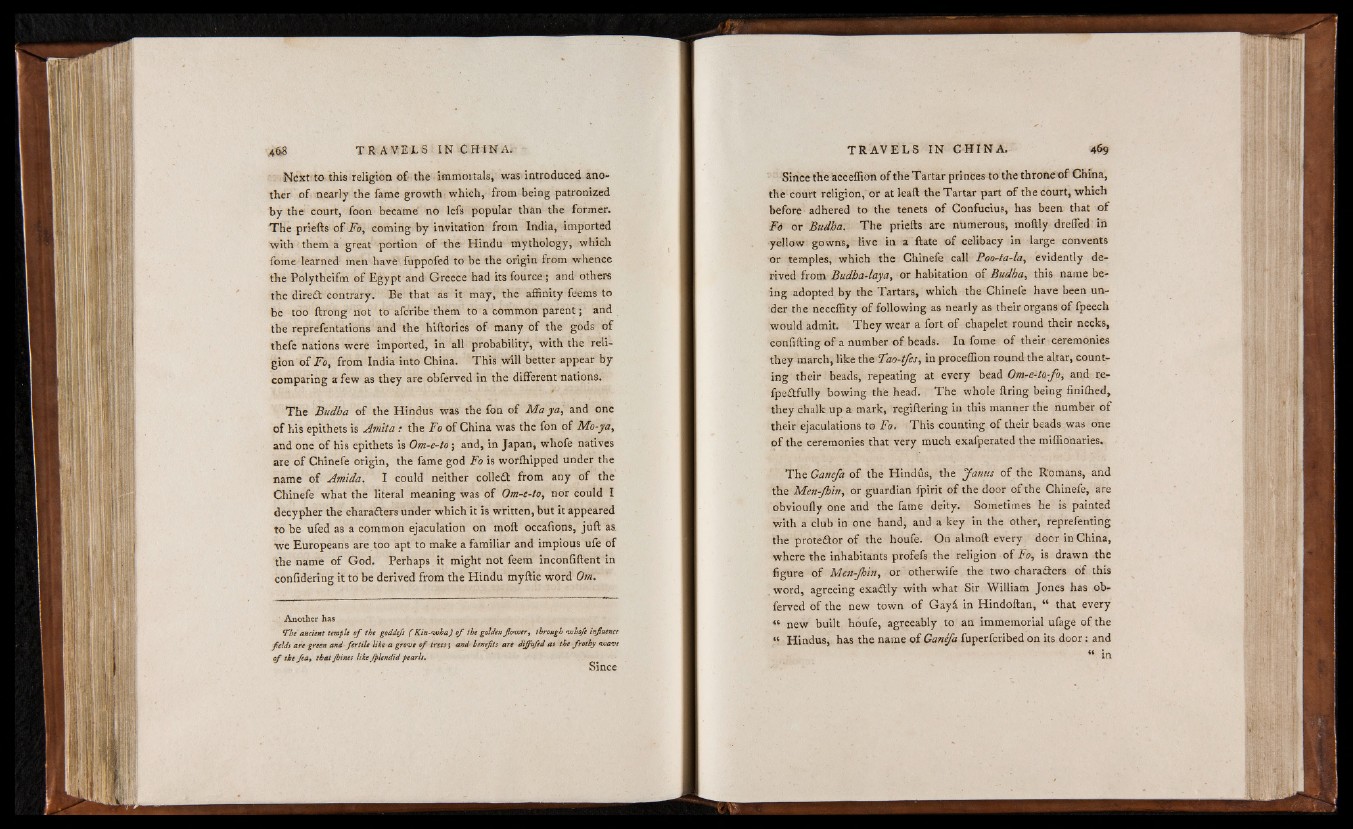
Next to this religion o f the immortals, was introduced another
o f nearly the fame growth which, from being patronized
by the court, foon became no lefs popular than the former.
T h e priefts o f Fo, coming by invitation from India, imported
with them a great portion o f the Hindu mythology, which
fome learned men have fuppofed to be the origin from whence
the Polytheifm o f Egypt and Greece had its fource ; and others
the direCI contrary. Be that as it may, the affinity feems to
be too ftrong not to afcribe them to a common parent; and
the reprefentations and the hiftories o f many o f the gods o f
thefe nations were imported, in all probability, with the religion
o f Fo, from India into China. This will better appear by
comparing a few as they are obferved in the different nations.
T he Budha o f the Hindus was the fon o f M a ya, and one
o f his epithets is shuita : the Fo o f China was the fon of Mo-ya,
and one o f his epithets is Om-e-to; and, in Japan, whofe natives
are o f Chinefe origin, the fame god Fo is worfhipped under the
name o f Amida. I could neither colled from any o f the
Chinefe what the literal meaning was o f Om-e-to, nor could I
decypher the characters under which it is written, but it appeared
to be ufed as a common ejaculation on moft occafions, juft as
we Europeans are too apt to make a familiar and impious ufe of
the name o f God. Perhaps it might not feem inconfiftent in
confidering it to be derived from the Hindu myftic word Om.
Another has
The ancient temple o f the goddejs ( Kin-wha) of the golden flower, through whofe influence
fields are green and fertile like a grove o f trees', and-benefits are diffufed as the frothy wave
of the fea, that Jhines like fplendid pearls.
Since
Since the acceffion o f the Tart ar princes to the throne of' China,
the court religion, or at leaft the Tartar part o f the court, which
before adhered to the tenets o f Confucius, has been that o f
Fd or Budha. The priefts are numerous, moftly dreffed in
yellow gowns, live in a ftate o f celibacy in large convents
or temples, which the Chinefe call Poo-ta-la, evidently derived
from Budba-laya, or habitation o f Budha, this name being
adopted by the Tartars, which the Chinefe have been under
the neceffity of following as nearly as their organs o f fpeech
would admit. T h e y wear a fort o f chapelet round their necks,
coniifting o f a number o f beads. In fome o f their ceremonies
they march, like the Tao-tjes, in proceffion round the altar, counting
their beads, repeating at every bead Om-e-to.-fo, and re-
fpe&fully bowing the head. The whole firing being finiffied,
they chalk up a mark, regiftering in this manner the number o f
their ejaculations to Fo. This counting o f their beads was one
o f the ceremonies that very much exafperated the miffionaries.
The Ganefa o f the Hindus, the Janus o f the Romans, and
the Men-Jhin, or guardian fpirit o f the door o f the Chinefe, are
obvioufly one and the fame deity. Sometimes he is painted
with a club in one hand, and a key in the other, reprefenting
the prote£tor o f the houfe. On almoft every door in China,
where the inhabitants profefs the religion o f Fo, is drawn the
figure o f Men-Jhin, or otherwife the two characters o f this
word, agreeing exaCtly with what Sir William Jones has obferved
o f the new town o f Gayá in Hindoftan, “ that every
“ new built hóufe, agreeably to an immemorial ufage o f the
“ Hindus, has the name o f Ganifa fuperfcribed on its door: and
“ in